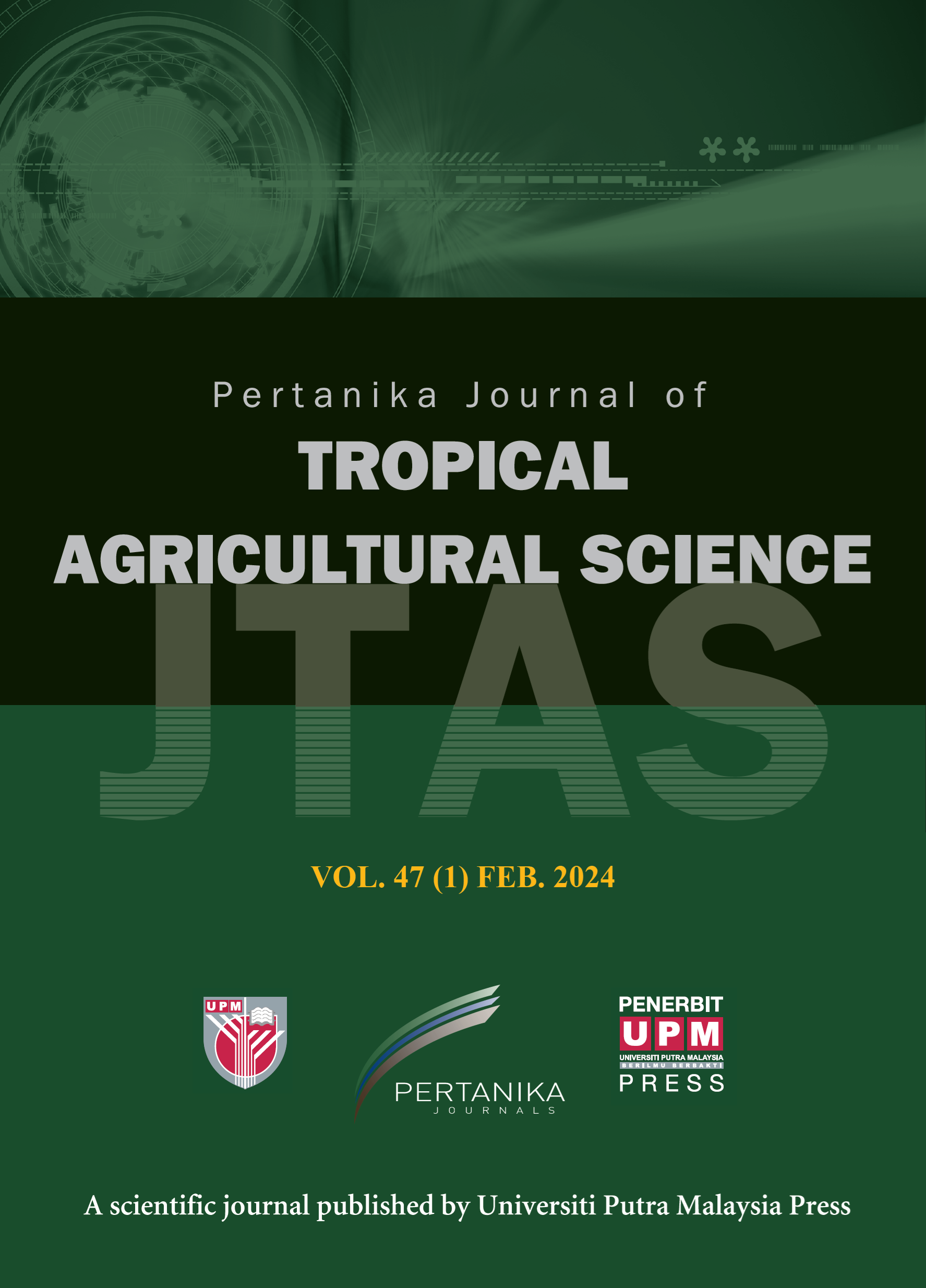PERTANIKA JOURNAL OF TROPICAL AGRICULTURAL SCIENCE
e-ISSN 2231-8542
ISSN 1511-3701
J
J
Pertanika Journal of Tropical Agricultural Science, Volume J, Issue J, January J
Keywords: J
Published on: J
J
-
Ahmed, Z. S., & Khan, Z. (2016). Direct and indirect impacts of terrorism on youth in Pakistan. Journal of the Research Society of Pakistan, 53(1), 235-249.
-
Algoe, S. B., & Haidt, J. (2009). Witnessing excellence in action: The ‘other-praising’emotions of elevation, gratitude, and admiration. The Journal of Positive Psychology, 4(2), 105-127. https://doi.org/10.1080/17439760802650519
-
Allport, G. W. (1937). Personality: A psychological interpretation. Holt.
-
Bader, G., & Rossi, C. (1998). Focus groups: A step-by-step guide. The Bader Group.
-
Baldwin, C. P., & Baldwin, A. L. (1970). Children’s judgments of kindness. Child Development, 41(1), 29-47. https://doi.org/10.2307/1127387
-
Baskerville, K., Johnson, K., Monk-Turner, E., Slone, Q., Standley, H., Stansbury, S., Williams, M., & Young, J. (2000). Reactions to random acts of kindness. The Social Science Journal, 37, 293-298. https://doi.org/10.1016/S0362-3319(00)00062-8
-
Binfet, J. T., & Gaertner, A. (2015). Children’s conceptualizations of kindness at school. Canadian Children, 40(3), 27-40. https://doi.org/10.18357/jcs.v40i3.15167
-
Braun, V., & Clarke, V. (2006). Using thematic analysis in psychology. Qualitative Research in Psychology, 3(2), 77-101. https://doi.org/10.1191/1478088706qp063oa
-
Bryan, W. V. (2015). The professional helper: The fundamentals of being a helping professional. Charles C Thomas Publisher.
-
Canter, D., Youngs, D., & Yaneva, M. (2017). Towards a measure of kindness: An exploration of a neglected interpersonal trait. Personality and Individual Differences, 106, 15-20. https://doi.org/10.1016/j.paid.2016.10.019
-
Cialdini, R. B., Brown, S. L., Lewis, B. P., Luce, C., & Neuberg, S. L. (1997). Reinterpreting the empathy–altruism relationship: When one into one equals oneness. Journal of Personality and Social Psychology, 73(3), 481. https://doi.org/10.1037/0022-3514.73.3.481
-
Cleary, M., & Horsfall, J. (2016). Kindness and its relevance to everyday life: Some considerations for mental health nurses. Issues in Mental Health Nursing, 37(3), 206-208. https://doi.org/10.3109/01612840.2016.1140546
-
Comunian, A. L. (1998). The kindness scale. Psychological Reports, 83(3), 1351-1361. https://doi.org/10.2466/pr0.1998.83.3f.1351
-
Crosnoe, R., & Johnson, M. K. (2011). Research on adolescence in the twenty-first century. Annual Review of Sociology, 37, 439-460. https://doi.org/10.1146/annurev-soc-081309-150008
-
Davey, A., & Eggebeen, D. J. (1998). Patterns of intergenerational exchange and mental health. The Journals of Gerontology Series B: Psychological Sciences and Social Sciences, 53(2), 86-95. https://doi.org/10.1093/geronb/53B.2.P86
-
Davidsen, A. S. (2013). Phenomenological approaches in psychology and health sciences. Qualitative Research in Psychology, 10(3), 318-339. https://doi.org/10.1080/14780887.2011.608466
-
DiSalvo, D. (2009). Forget survival of the fittest: It is kindness that counts. Scientific American. https://www.scientificamerican.com/article/forget-survival-of-the-fittest/
-
Exline, J. J., Lisan, A. M., & Lisan, E. R. (2012). Reflecting on acts of kindness toward the self: Emotions, generosity, and the role of social norms. The Journal of Positive Psychology, 7(1), 45-56. https://doi.org/10.1080/17439760.2011.626790
-
Flood R. L., & Carson E. R. (1993). Dealing with complexity: An introduction to the theory and application of systems science (2nd ed.). Plenum Press.
-
Frank, D. (2010, May 5). Can babies tell right from wrong? The New York Times. https://www.nytimes.com/video/magazine/1247467772000/can-babies-tell-right-from-wrong.html
-
Goodwin, G. L. (2011, May 9). Kindness: The core of 12 religions. Inspire Me Today. https://inspiremetoday.com/blog/kindness-the-core-of-12-religions/
-
Haidt, J. (2003). The moral emotions. Handbook of effective sciences, 11, 852-870. Oxford University Press.
-
Index Mundi. (2018). Pakistan Demographics Profile 2018. Index Mundi. https://www.indexmundi.com/pakistan/demographics_profile.html
-
Jacob, S. A., & Ferguson, S. P. (2012). Writing interview protocols and conducting interviews: Tips for students new to the field of qualitative research. The Qualitative Report, 17(42), 1-10. https://doi.org/10.46743/2160-3715/2012.1718
-
Kohn, A. (1990). Effects of rewards on prosocial behavior. Cooperative Learning, 10(3), 23.
-
Kvale, S. (1989). To validate is to question. In S. Kvale (Ed.), Issues of validity in qualitative research (pp. 73-92). Studentlitteratur.
-
Leahy, R. L. (1979). Development of conceptions of prosocial behavior: Information affecting rewards given for altruism and kindness. Developmental Psychology, 15(1), 34. https://doi.org/10.1037/0012-1649.15.1.34
-
Lewis, J., & Ritchie, J. (Eds.). (2003). Qualitative research practice: A guide for social science students and researchers. Sage Publications.
-
Lyubomirsky, S., Sheldon, K. M., & Schkade, D. (2005). Pursuing happiness: The architecture of sustainable change. Review of General Psychology, 9(2), 111-131. https://doi.org/10.1037/1089-2680.9.2.111
-
McGarry, L. J. (1986). Kindness and human nature: thoughts on the high cost of negativeness. Villanova University Press.
-
Mischel, W., & Shoda, Y. (1995). A cognitive-affective system theory of personality: reconceptualizing situations, dispositions, dynamics, and invariance in personality structure. Psychological Review, 102(2), 246. https://doi.org/10.1037/0033-295X.102.2.246
-
Neff, K. D. (2003). The development and validation of a scale to measure self-compassion. Self and Identity, 2(3), 223-250. https://doi.org/10.1080/15298860309027
-
Otake, K., Shimai, S., Tanaka-Matsumi, J., Otsui, K., & Fredrickson, B. I. (2006). Happy people become happier through kindness: A counting kindnesses intervention. Journal of Happiness Studies, 7(3), 361-375. http://doi.org/10.1007/s10902-005-3650-z
-
Pagel, M. (2012). Wired for culture: The natural history of human cooperation. Penguin UK.
-
Peterson, C., & Seligman, M. (2004). Character strengths and virtues: A handbook and classification (Vol. 1). Oxford University Press.
-
Phillips, A., & Taylor, B. (2009). On kindness. Hamish Hamilton Press.
-
Pollock, L. A. (2011). The practice of kindness in early modern elite society. Past and Present, 211(1), 121-158. https://doi.org/10.1093/pastj/gtq056
-
Rich, G. J. (2003). The positive psychology of youth and adolescence. Journal of Youth and Adolescence, 32(1), 1-3. https://doi.org/10.1023/A:1021017421413
-
Rowland, L. (2018). Kindness: Society’s golden chain.The Psychologist, 31, 30-34.
-
Rutherford, E., & Mussen, P. (1968). Generosity in nursery school boys. Child Development, 755-765. https://doi.org/10.2307/1126981
-
Schnall, S., & Roper, J. (2012). Elevation puts moral values into action. Social Psychological and Personality Science, 3(3), 373-378. https://doi.org/10.1177/1948550611423595
-
Stewart, D., & Shamdasani, P. (1990). Focus groups: Theory and practice. Sage Publications.
-
Strenta, A., & Dejong, W. (1981). The effect of a prosocial label on helping behavior. Social Psychology Quarterly, 44, 142-147. https://doi.org/10.2307/3033711.
ISSN 1511-3701
e-ISSN 2231-8542




